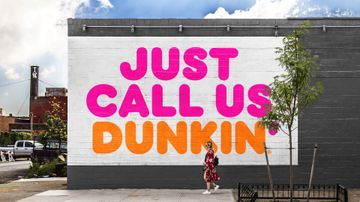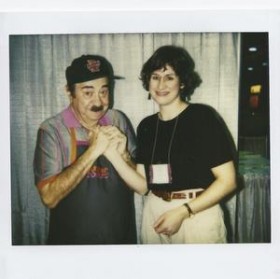This post originally appeared in March 2012 and remains one of my most popular. Updated on July 10, 2020.
That’s me in the Polaroid instant photo with actor Michael Vale, better known as Fred the Baker, or the guy who used to utter “Time to make the donuts.” Mr. Vale was at the Dunkin’ Donuts National Convention at Disney World in 1996 to grace franchisee and employee fans like me with a photo opportunity.
Mr. Vale had been portraying Fred the Baker for 14 years by the time we had our brief encounter. Much had changed for Dunkin’ Donuts in that time.
Competition heated up. Starbucks grew from 33 stores in 1988 when Howard Schultz bought the company to 165 in 1992 when it went public to 1,015 in 1996.
In 1995 Wendy’s International purchased Tim Horton’s, a donut and coffee chain that was beating Dunkin’ handily in the Canadian market, and threatened to expand that chain into the U.S..
Krispy Kreme expanded beyond its Southeast roots, opening its first New York store in 1996.
Company ownership changed. Allied Lyons bought Dunkin’ Donuts in 1990. In addition to gaining Baskin-Robbins as a sister company, Dunkin’ management now had to take Allied’s desire for return on investment into account.
Health consciousness surged. The 1980s and 1990s marked the appearance of several diet programs (The Beverly Hills Diet, Jenny Craig, Optifast, The Zone Diet) and the explosive growth of others (Weight Watchers, Atkins).
Meanwhile, back at the ranch, Dunkin’ management wanted to make the business more attractive to franchisees and more profitable.
The Early Shift to Coffee
It was clear that Dunkin’ would need new products and a new approach given the external forces above that were bearing down on the company.
Dunkin’ shifted its emphasis to coffee, which was less labor intensive and more profitable than donuts.
We also launched Dunkin’ Bagels, Coffee Coolattas, and combination stores where Dunkin’ Donuts and Baskin-Robbins partnered in the same retail space.
What does all this have to do with Fred? Well, as the guy who made the donuts, he represented our past but not our future.
As the changes were occurring, a close observer could see the shift already in the commercials he did.
In the 1980s Dunkin’s commercials focused on doughnuts (like this Fred classic) and how Dunkin’ made them fresh daily in contrast to supermarkets’ stale offerings. Supermarkets were Dunkin’s major competition at the time.
By the 1990s, Fred was serving coffee in some commercials.
Ultimately though, we needed a fresh start. After research showed that our customers would allow us to move beyond Fred if we treated him well, we threw him a huge retirement bash complete with a parade in Boston and a free doughnut day for customers.
Every brand has external forces exerting pressure and willing it to evolve. As the steward of your brand, you need to track these changes and evolve the brand to take advantage of them. Done well, brand evolution can position your brand as a market leader.
Remain Relevant or Become History
Ignoring changes in your market and business environment is the ostrich approach and can kill your brand. Look what it did to the brand that helped produce my photo with Fred.
Polaroid concentrated on its iconic instant camera too long – first in the face of one-hour film processing at retail outlets and then as digital cameras appeared. The company filed for bankruptcy in October 2001 and sold its assets, including the right to the Polaroid name.
The name and the assets bounced from owner to owner. In December 2008, the Polaroid Corporation declared bankruptcy again.
In February 2008 on its second march to bankruptcy, Polaroid announced it would close its last remaining instant film factory in Enschede in the Netherlands.
Instant-film fanatic and online seller Florian Kaps bought the factory and launched The Impossible Project with former factory employees to resurrect instant film production there. (See their passion for the resurrection here.)
The Impossible Project rebranded as Polaroid Originals in 2017 when the CEO purchased Polaroid’s holding company. In March 2020 the company became just Polaroid.
Still the brand that was an American icon remains a shadow of its former self.
Brand Relevance is Defined by Customer Experience, Not Product
Where Polaroid went wrong was to focus on the product – the physical instant camera, film and paper – instead of building the brand around a purpose that fueled customers’ emotional attachment: instant memory capture.
Had Polaroid’s management used the brand’s ability to own the attribute “instant” to develop their digital photography market alongside their analog products, the brand might not have disintegrated.
Dunkin’ did not make that mistake. While the company shifted its product focus to revolve more around coffee, management knew the brand’s strength came from the role it played in customers’ lives.
Customers indicated that a stop at Dunkin’ was the way they recharged physically and emotionally. It was a treat they gave themselves, a way to keep them going the rest of the day.
This insight gave rise to the “America Runs on Dunkin’” campaign which launched in 2006 and continues today.
How Dunkin’ Has Remained Relevant
Dunkin’s shift to a coffee emphasis has been successful. By 2010, 60 percent of the Dunkin’ Donuts brand sales came from beverages.
But it is the continued focus on providing customers with physical and emotional fuel, along with convenience and speedy delivery that keeps the brand relevant and growing.

Recent ways Dunkin’ has evolved to remain relevant include:
- Dropping ‘Donuts’ from the brand name to reflect the beverage-leading focus.
- Implementing a NextGen store design to allow speedier service, including an express pick up lane for customers who ordered and paid via mobile app.
- Completing the brand’s transition from polystyrene foam cups to paper cups to operate in a more environmentally sustainable manner.
- Implementing gloves, masks and plexiglass shields in stores early in the pandemic crisis.
- Transferring savings from voluntary management and Board of Directors’ salary and fee reductions to the Dunkin’ Brands Family Fund to help crew members in time of crisis.
Keep Your Brand Relevant
No brand is immune to the need to evolve. What can you do to help your brand stay relevant?
- Talk to your customers. Your brand needs an on-going conversation with them to maintain a deep knowledge of your audience and to reflect that in the experience you deliver.
- Track consumer trends. Think about how they may influence your brand’s perception and usage. Implement customer experience elements, product changes and new offerings that arise from the intersection of these trends with your brand.
- Know what your competition is doing. Study their website, financial filings and press releases. Follow them on social media. When possible, visit their brick and mortar stores. Anticipate how a competitor’s new product launch may affect you…or better yet, launch a forward-looking product that changes the game in your favor.
- Follow regulatory changes in your industry.
- Look at other industries for innovation ideas.
In short, keep your eyes, ears and mind open.
I cherish that old photo with Mr. Vale, and remember the excitement of getting to meet him.
Do you remember Fred the Baker?
If you liked this post, you’ll love the next one.
To have future posts sent to your inbox...


Dunkin has evolved in many ways, both positive and negative. Food quality has suffered as has quality of customer service. The brand has become closer to McDonald’s than Starbucks over the years. I am glad I put in a decade at Dunkin corporate when I did versus now. I would be embarrassed at the lack of positive consumer engagement.
Chris, it’s unfortunate that you feel that way but I respect your view. I too enjoyed working there – it was a fun and energetic time that moved the needle positively for the brand. I’ve mostly seen it through the corporate eyes from that time and what I have read, however. I was never really their target market. You may not recall, but I don’t even drink coffee!
Are you speaking from the experience of being a customer yourself?
Chris is right abt food & customer service. I noticed the decline in both as a customer. Also too many Haji’s.
Possessing a marketing degree, I understand and see the logic of your article but I’m very disappointed with the results. Fred’s rolling over in his grave.
I will always stop at a Tim Hortons over a Dunkin.
JLR, I can understand your disappointment. I wrote of strategic changes, while you and Chris focused on the tactical delivery, the ways customer service and food quality have declined. Both can co-exist. And it is a good insight to note: strategic smarts mean little if the execution stinks.
If you prefer Tim Horton’s to Dunkin’, perhaps you are in or from Canada? Most Americans don’t know that Canadian brand unless they’ve been to Canada or live close to the border.
The brand transformation during that time in the 90s was really exciting. I think the corporate office and the work environment was fun and friendly which led to wanting the same in the stores. It is all rushed and crowded in the stores now.
I’m not a fan of the name change. It messes with the logo and it does not look right. I also remember doing market research on dropping donuts that indicated people didn’t care.
Glad to have worked with you!
It was such an exciting time Maura! Their was also an intensity as together we tried to affect many changes at once – launching bagels, redesigning stores, launching Coolattas and shifting to central baking facilities.
I may have had something to do with that research. 🙂 What I remember most was the strong equity Dunkin’ has in the orange and pink. I like the name change. It feels natural to me as we were all referring to the brand as Dunkin’ at the time, even if it was just shorthand.
I’m so glad to have worked with you too! Hope you are well and safe.